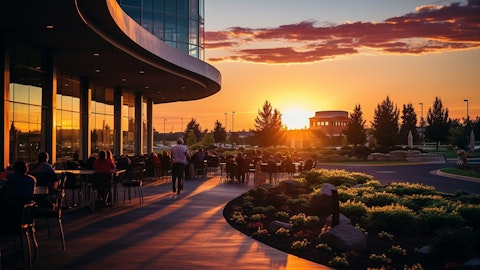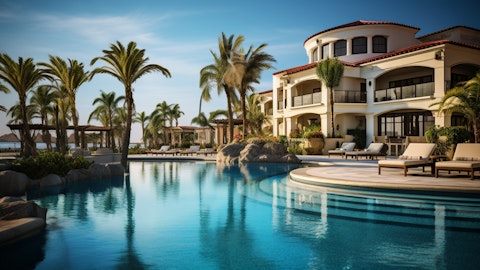Scott Kreeger: This is Scott. I’ll take it. And maybe someone else can jump in. Let’s start by just saying and reiterating what we’ve said in the past. We think we’re an employer of choice for a lot of reasons. One, because of our culture, and two, because of our benefits package. We think it’s very competitive in the marketplace. We had a very successful hiring process for Durango, so we tested that in the market, and we found that our compensation package and benefits was very competitive. That being said, we want to remain competitive. And with the increases that will come with the new contracts, we’re definitely going to have to look and make sure that we’re competitive. And so there will be some consideration there. But as Steve likes to say, all the time, all of those 60,000 plus Culinary workers that got raises are also, a lot of them are our customers. So there’s a waterfall effect there that benefits us on the other side.
Barry Jonas: Got it. Got it. And then just for a follow-up, can you talk a little bit about your tavern strategy here and how you’re thinking about organic growth versus M&A?
Scott Kreeger: Yes. So taverns are an interesting new segment that we’re looking at. It’s a very micro local segment, it’s a neighborhood segment. It has a different customer profile that we find attractive, and we find that the investment returns on taverns is pretty attractive. We have a strategy where we’d like to create penetration in high net worth, high growth areas of the valley, kind of akin to our large site development strategy. And look, we look at everything, whether that’s an acquisition or a ground up or build the suit situation. But we always find that having our own footprint to design a project the way we want it designed in a new emerging area is probably our method of choice. But we’ll look at everything that makes sense.
Barry Jonas: Perfect. Thank you.
Operator: The next question comes from Dan Politzer with Wells Fargo. Please go ahead.
Dan Politzer: Hey, good afternoon, everyone. Thanks for taking my questions. I was more curious just in general, in the market, obviously a big new property opening. You’re going to see a pickup in promotional spend, I guess, any detail on what you saw over the course of the quarter and into January, maybe over the past week or so in terms of the market and remaining rational?
Scott Kreeger: This is Scott. It’s really a lot more of the same. So it’s stable and you have a pretty rational market. You do have the one off outliers that have been promotional and remain promotional as a strategy. There’s not been any noticeable change in the market that has affected us.
Dan Politzer: Got it. And then just for my follow-up, I think you guys have talked about that 20% return on capital getting there for Durango, I believe the course of three years. But given the strength of the opening and the momentum out of the gate, I mean, is there any difference in cadence of how you’re thinking about that? And then just along those lines, is there any nuance here in terms of gaming versus non-gaming mix at that property? I just noticed overall for the portfolio, it was a little different than typical seasonality. Thanks.
Stephen Cootey: This is Steve. I think the ramping profile remains the same. These are very early days. We’re very happy with the opening, but there’s still a lot of work.
Frank Fertitta: Still settling in.
Stephen Cootey: It’s still settling in. In terms of the mix, it should follow – it should match our current system mix.
Frank Fertitta: Maybe a little higher on gaming.
Stephen Cootey: Higher on gaming just given limited hotel rooms and amenity.
Dan Politzer: Understood. Thanks so much.
Operator: The next question comes from Stephen Grambling with Morgan Stanley. Please go ahead.
Stephen Grambling: Hey everyone. Just going to reask a bit on cannibalization comment, I guess any sense for how quickly you think you could backfill? And did you take any actions or feel like you needed to take any actions to offset any of the cannibalization in any of your other properties from an expense standpoint or was it just too small?
Frank Fertitta: I think it might be just a little too early. So we want there to be trial. We want everybody in the valley to come and try out Durango and see it. What you see typically from our previous openings as you see a very early, strong visitation from in brand customers but then you tend to see a dip where they go back to their neighborhood property that they’re familiar with. So we’re in the throes of kind of understanding what that period is. And then over time what we’ve seen in our previous openings is two-fold. One, you see the existing property backfill and grow, and we’re talking predominantly Red Rock, which is in one of the highest growth areas in the valley. Summerlin master-planned development is the fourth best master-planned development in the country this year.
So Red Rock has its own backfill story. And then the other thing you see is Durango being in a new market that was underpenetrated and lacks additional competition. You’re going to see Durango continue to grow its database and the surrounding area over the next three years. And really it never will stop.
Scott Kreeger: I mean, yes, there’s a tremendous amount of new rooftops that will be coming online out there over the next year to three years, lots of apartments and everything else. So we’ll see where Durango settles in after a great opening. And then we’d expect it to be a growth asset for decades to come just to get. We’re early days right now.
Stephen Grambling: That’s helpful. And one other just clarification you were talking about labor inflation a little bit earlier. I guess when we put it all together and you think about core OpEx growth next year, how would you characterize where you’re thinking kind of core OpEx growth X the kind of moving parts around Durango would be?




